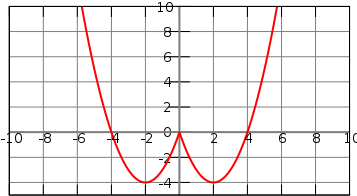A-level Mathematics/OCR/C3/Special Functions and Transformations
The Modulus Function[edit | edit source]

The modulus function is written as and it is defined as . You can also write , because the quadratic power will make any negative positive and then you take the surd and the function becomes the original function. The modulus function has a many:1 mapping, and therefore there is no inverse function. The modulus function is used when the value of the resultant is important not its sign. Only in British English is the term Modulus Function used otherwise it is called the Absolute Value Function. So on most calculator you will see abs().
Solving Modulus Inequalities[edit | edit source]
When solving an inequality involving a modulus it is important to remember that you cannot simply ignore the modulus. Instead you need to use the rule: . Then you solve as you would a regular problem. In example:
Solve for x
Graphing The Modulus Function[edit | edit source]
The Graph of y=|f(x)|[edit | edit source]
In the graph of , the negative side of the graph is reflected through the x-axis. Below is the graph of
The Graph of y=f(|x|)[edit | edit source]
In the graph of , the positive side of the graph is reflected through the y-axis. Below is the graph of .
The Natural Functions[edit | edit source]

The Natural Exponent Function[edit | edit source]
The base e is a transcendental function defined by an infinite series, which approximately is 2.71828:
.
e is one of the most important number in mathematics because of its use in most natural growth processes calculations. Since it is an exponential function it follows all the laws of exponential functions. The natural exponent is the inverse function of natural logarithm, so that . On the right is the graph of .
The Natural Logarithm[edit | edit source]
The natural log is a logarithmic function with the base e: . It has a special notation of . Since the natural logarithm is a logarithmic function it follows all the laws of logarithmic functions. The natural logarithm is the inverse function of natural exponent, so that . On the right is the graph of .
Exponential growth and decay[edit | edit source]
One of the primary usage of the natural functions is the calculation of natural growth or decay, which can be calculated using the following formula: , where y(t) is the final value, is the initial value, k is the growth constant, t is the elapsed time. One special decay is the half life of an element there k is defined as: . Exponential growth and decay have a very broad range of applications from measuring the growth bacteria colony to calculating involving interest.
Example of Exponential Growth[edit | edit source]
A bacterial colony was started with 200 bacteria, in 2 hours the colony has grown to 600 bacteria. Predict the quantity of bacteria in the colony in 6 hours?
From this we know:
- y(t) = 600
- = 200
- k = x
- t = 2
Now we substitute the values into the formula:
Now we ensure that e is alone:
Since ln is the inverse function we use it to remove the base e.
We can now solve for x.
, so the growth factor for the colony is approximately .55
Now we can predict the quantity of bacteria after 6 hours.
Example of Half-life decay[edit | edit source]
The element Carbon-14 has a half-life of 5730 years. When will a 100 gram sample of C-14 be reduced to 20% C-14 and 80% C-12?
- y(t) = 20% * 100 = 20
- = 100
- half-life = 5730
- t = x
We substitute all knows into the function. Note the special formula for the growth constant.
Now we ensure e is alone:
Since ln is the inverse function we use it to remove the base e.
Now we rearrange the equation to isolate t.
Solving for t we get that the sample will be reduced to 20% C-14 and 80% C-12 after about 13304.6 years.
Transformations of Functions[edit | edit source]
In Core 3 we finish our table of transformations with three more reflections. Below is the complete table of transformations.
Reflection[edit | edit source]
- is a reflection of through the x axis.
- is a reflection of through the y axis.
- is a reflection of when y < 0, through the x-axis.
- is a reflection of when x > 0, through the y-axis.
- is a reflection of through the line y=x. must have a 1:1 mapping.
Stretching[edit | edit source]
- is stretched away from the y-axis if and stretched towards the y-axis if . In both cases the change is by 1/b units.
- is stretched towards the x-axis if and stretched away from the x-axis if . In both cases the change is by a units.
Translations[edit | edit source]
- is a translation of f(x) by h units to the right.
- is a translation of f(x) by h units to the left.
- is a translation of f(x) by k units upwards.
- is a translation of f(x) by k units downwards.
Example[edit | edit source]
Describe how the function can be mapped onto .
1) A reflection through the x-axis.
2) A stretch by 4 in the x-direction
3) A shift in the x plane by 5 units to the left, alternatively written as a reflection through x = -5.
4) A shift in the y plane by 10 units up.
5) A reflection through y = x.
6)A reflection of when y < 0, through the x-axis.
7)A reflection of when x > 0, through the y-axis.
Now for the graph:
 Not very easy to recognize as the graph of with transformations.
Not very easy to recognize as the graph of with transformations.
This is part of the C3 (Core Mathematics 3) module of the A-level Mathematics text.



















































